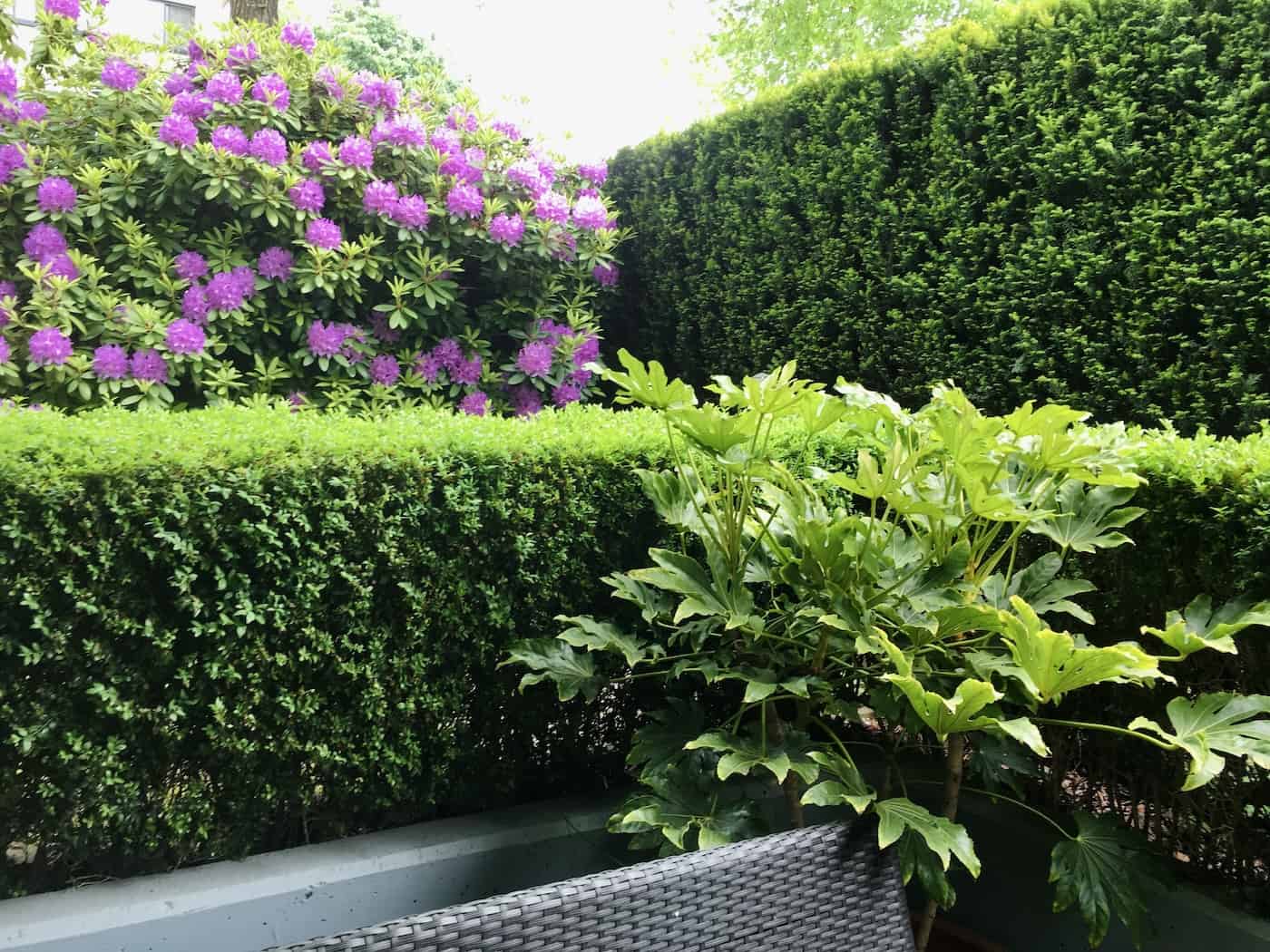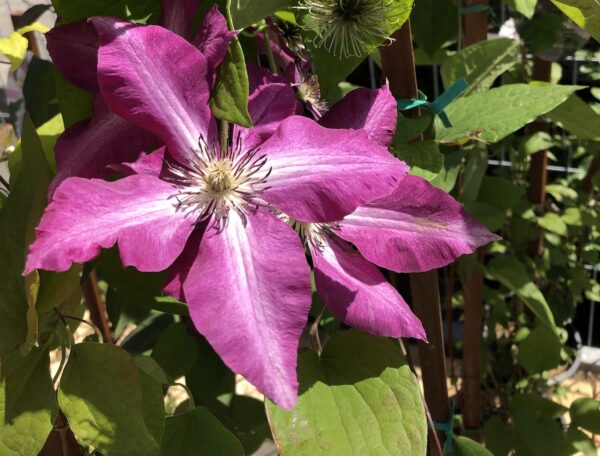Choosing appropriate shrubs for shade gardens and low-light spots is key to creating a vibrant landscape. While most shrubs really do need quite a lot of fun to fill out nicely, there are a few dozen standout shade shrubs that are favorites for a reason.

1. Boxwood
Boxwood (Buxus spp.) is a popular evergreen shrub known for its dense, compact foliage and versatility in landscaping. This shrub is an excellent choice for shaded areas, as it thrives well in both partial and full shade, making it ideal for under trees or in the shadow of buildings.
Boxwoods can be grown reliably in USDA zones 5 through 9. They prefer well-drained soil and benefit from some protection against harsh winter winds in colder zones.
Annual maintenance when growing shrubs like boxwoods typically involves pruning to shape the plant, which is best done in late winter or early spring to maintain its desired form and promote healthy growth. Additionally, a spring application of fertilizer suitable for evergreens can help maintain their vibrant green foliage.
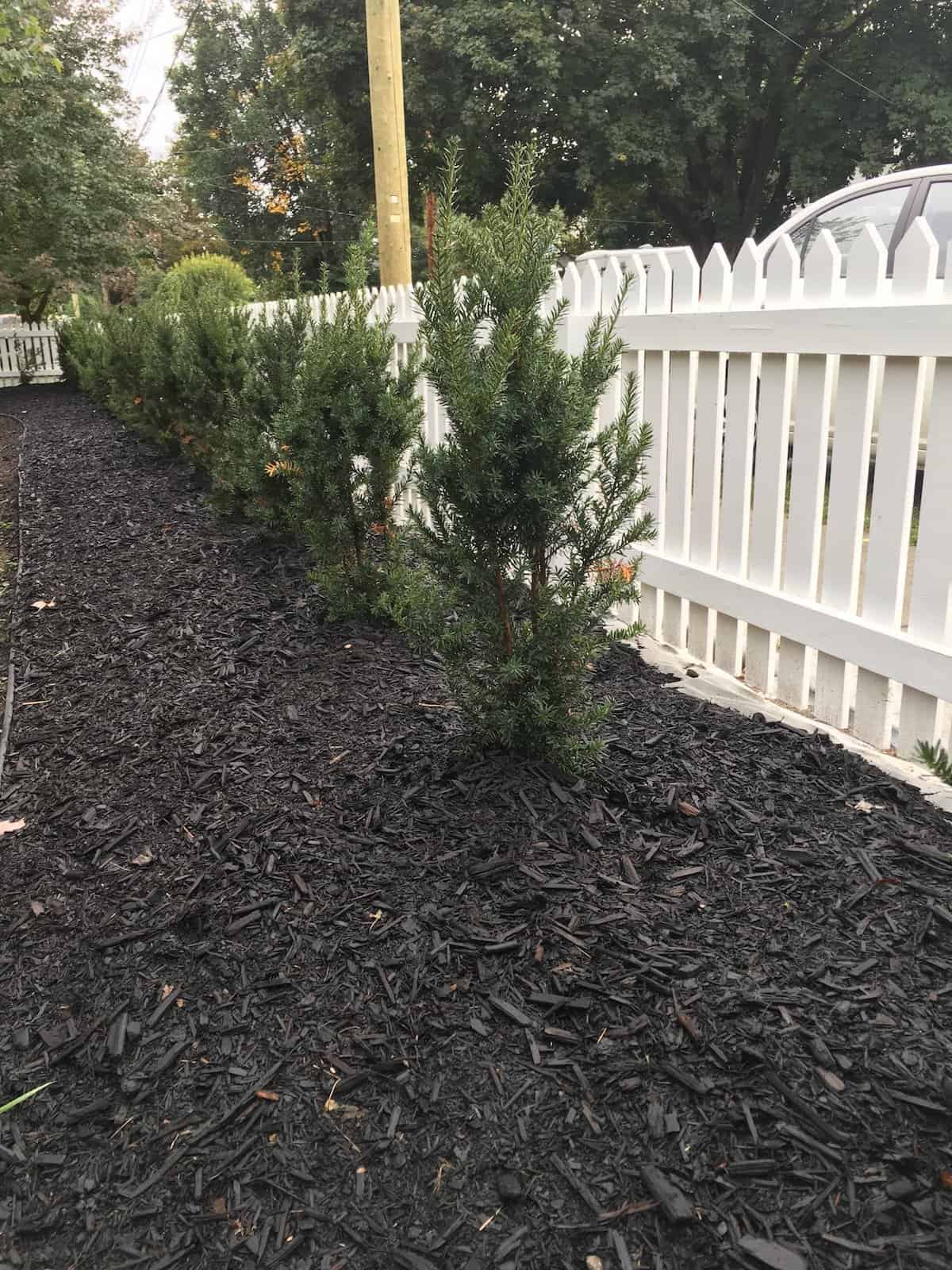
2. Yew
Yew (Taxus spp.) is a resilient and versatile evergreen shrub renowned for its dense, needle-like foliage and red berries. Its tolerance for shade makes it an excellent choice for landscaping in less sunny areas, where it can provide year-round greenery and structure.
Yews thrive in USDA plant hardiness zones 4 through 7. They are adaptable to various soil types, though they prefer well-drained soil. This shrub can withstand heavy pruning, making it ideal for shaping into neat hedges or even topiary forms if you so desire. They are also very long-lived plants and can add value to your landscape beyond the immediate curb appeal benefits.
Yews are quite low-maintenance compared to other landscaping shrubs. Annual work typically involves pruning to control size and shape, ideally in late winter or early spring. In poor soil, you can apply an evergreen fertilizer in the springtime. It’s important to note that while yews are durable and low-maintenance, their leaves and seeds are toxic if ingested.
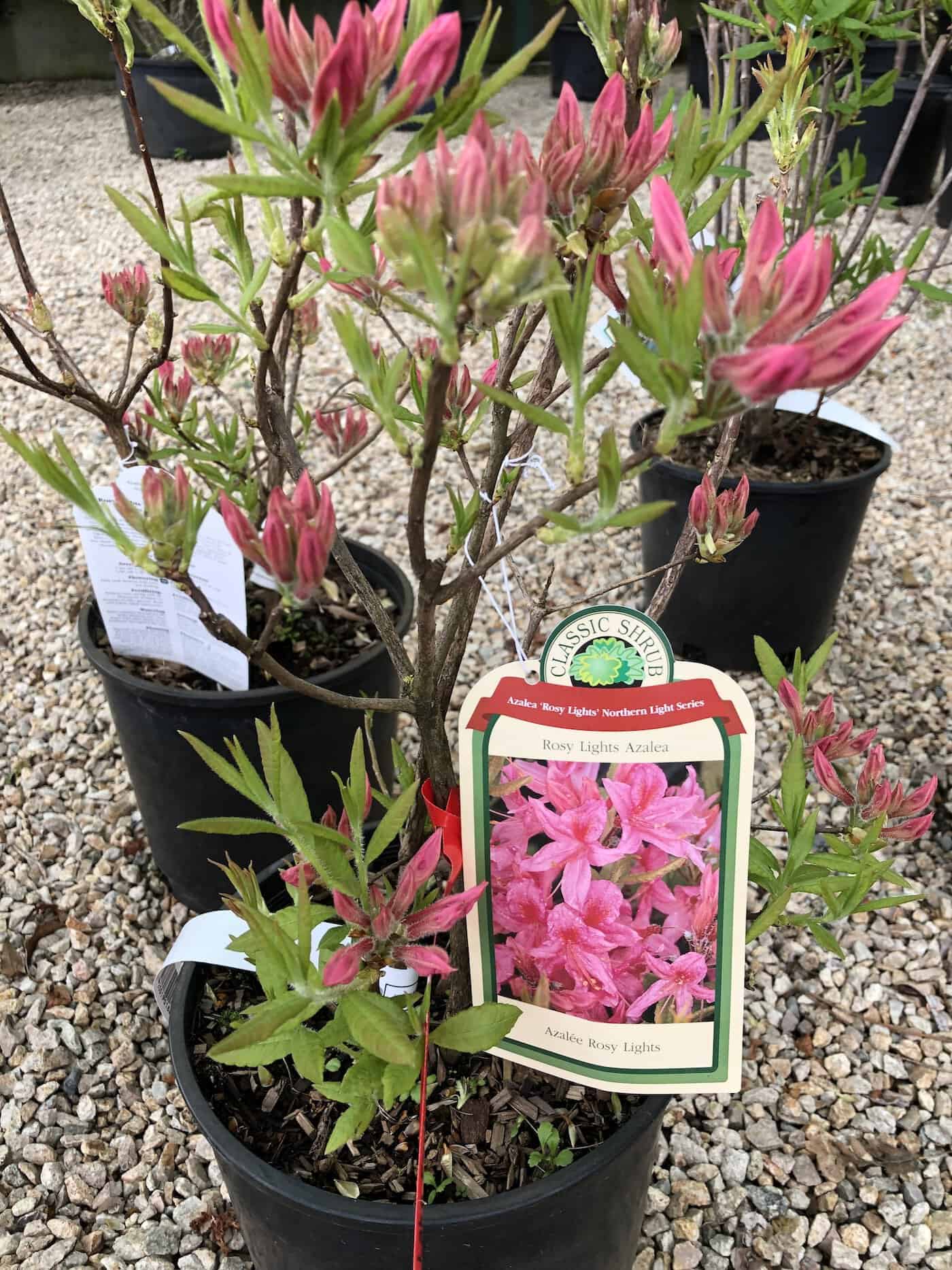
3. Azalea
Azalea (deciduous Rhododendron spp.) is a flowering shrub known for its vibrant blooms, which are available in a variety of colors. Ideal for shaded locations in landscaping, azaleas flourish under canopy cover or in areas with filtered sunlight, mimicking their natural understory habitat.
Azaleas need well-drained, acidic soil to thrive. They are suitable for USDA plant hardiness zones 5 through 8, although they may need some winter protection at the colder end of their growing range. Azaleas require consistent moisture but are sensitive to overwatering, making proper soil drainage crucial for their health.
Annual maintenance includes pruning immediately after flowering to shape the shrub and applying a layer of mulch to the soil around the plant to help retain moisture and regulate temperature. Additionally, an acid-forming fertilizer may be applied in early spring to support their blooming and overall health.
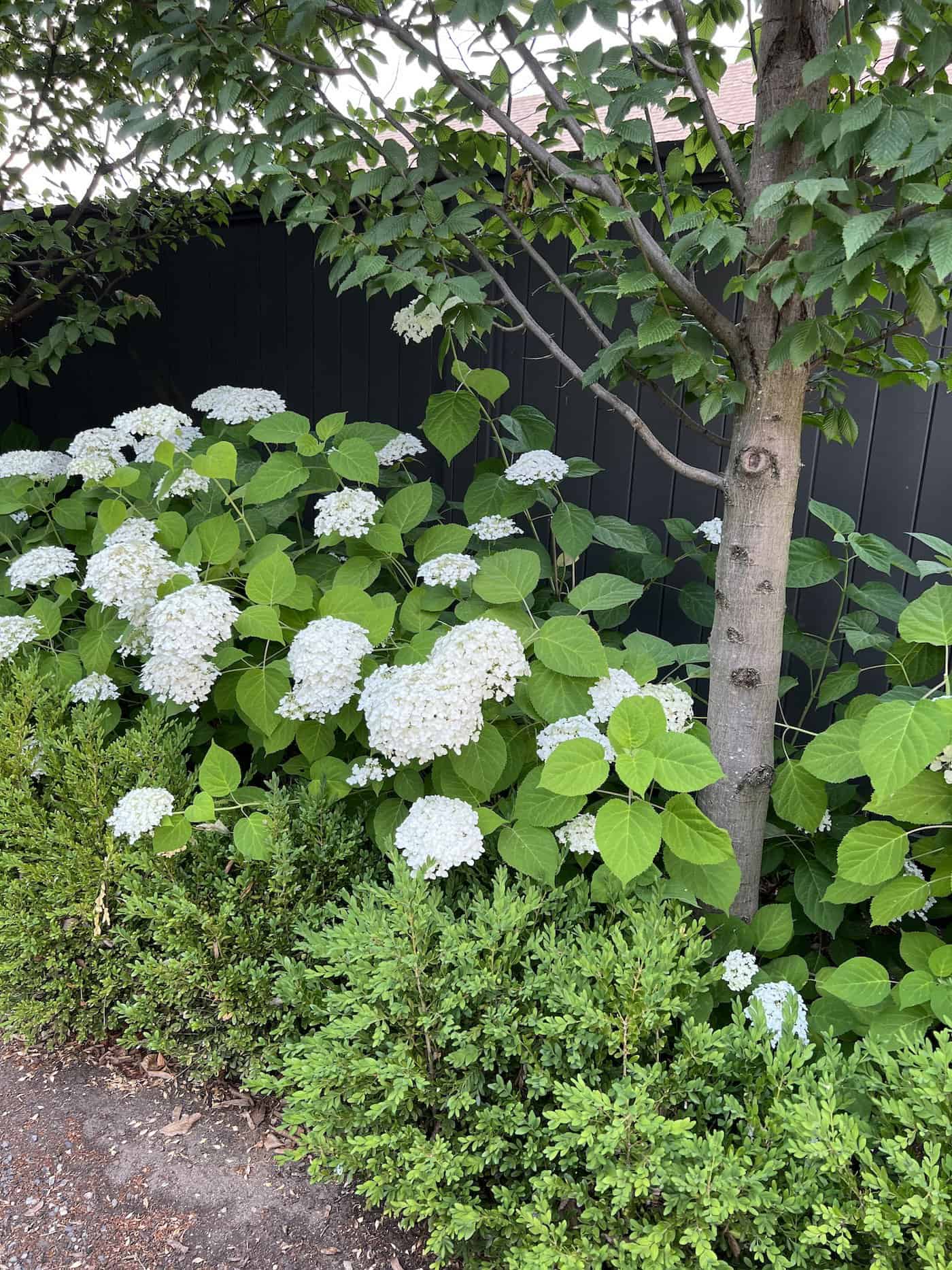
4. Hydrangea
Hydrangeas (Hydrangea spp.) are renowned for their large, showy blooms that come in a variety of colors. These shrubs are a good choice for shaded locations in landscaping as many types prefer partial shade, especially in the afternoon, to protect their blooms from intense sun.
There are a handful of different types of hydrangeas, each of which thrives in slightly different conditions. The classic blue or pink mophead types are perfect for shaded gardens in the south, while mountain or smooth hydrangeas are better suited to the colder climates of zones of 3-5 or so. In general, hydrangeas thrive in moist, well-drained soil and do best when shielded from the hot afternoon sun.
Annual maintenance for hydrangeas includes pruning, which varies depending on the species; some like a bit of pruning in late winter or early spring, while others only need deadheading after blooms fade. Regular watering and mulching help retain soil moisture and protect the roots, and applying fertilizer in early spring can promote healthy growth and vibrant blooms.
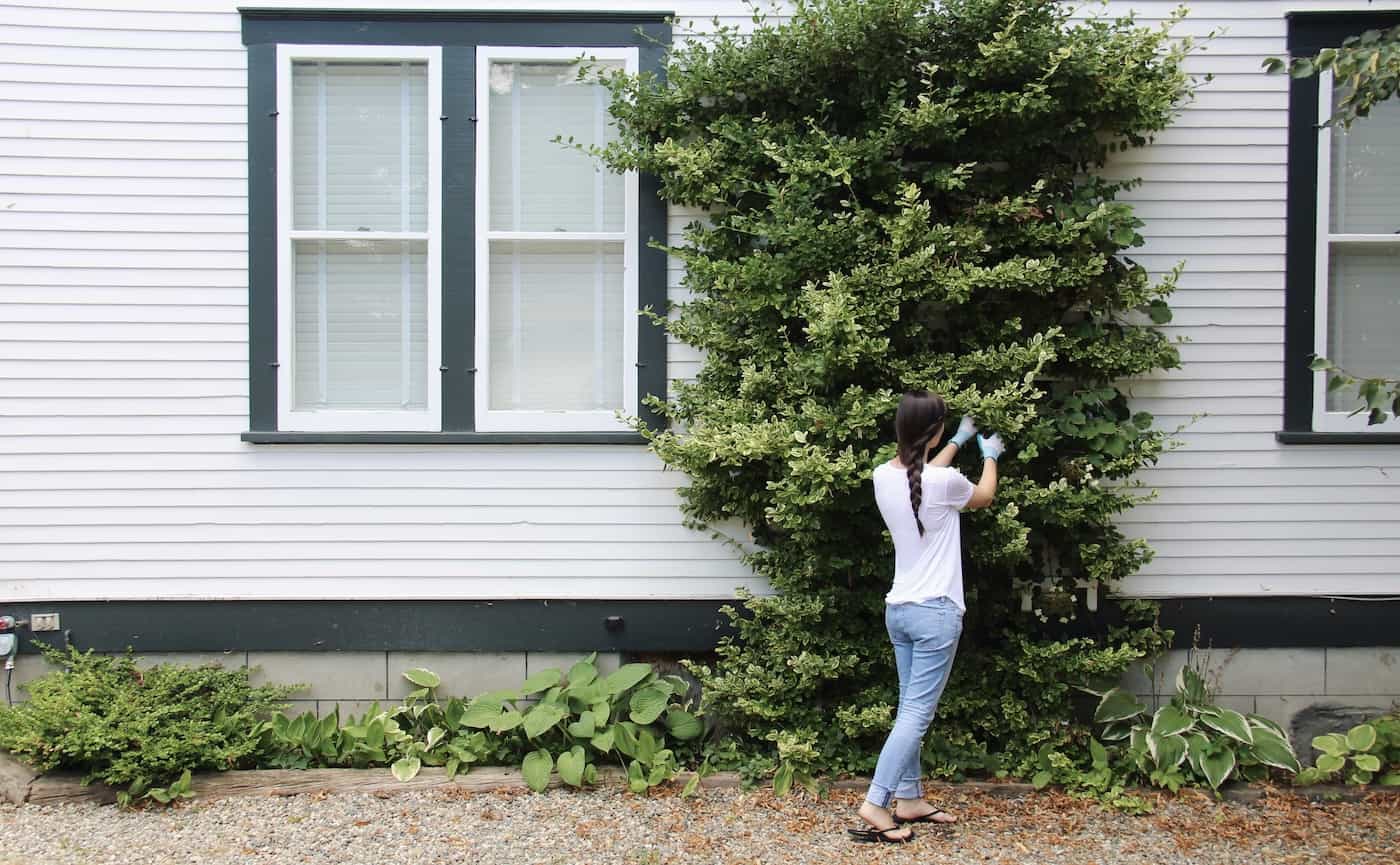
5. Euonymus
Euonymus (Euonymus spp.) is known for its attractive foliage. Its ability to adapt to and even thrive in shade makes it a valuable addition to areas where other plants might struggle. It’s a great way of providing color and texture under trees, on north-facing walls, or in other low-light spots.
This shrub thrives in well-drained soil and is hardy in USDA plant hardiness zones 4 through 9. Euonymus plants are relatively low maintenance but can benefit from occasional pruning to shape the plant and encourage fuller growth. Annual mulching can help retain soil moisture and suppress weeds.
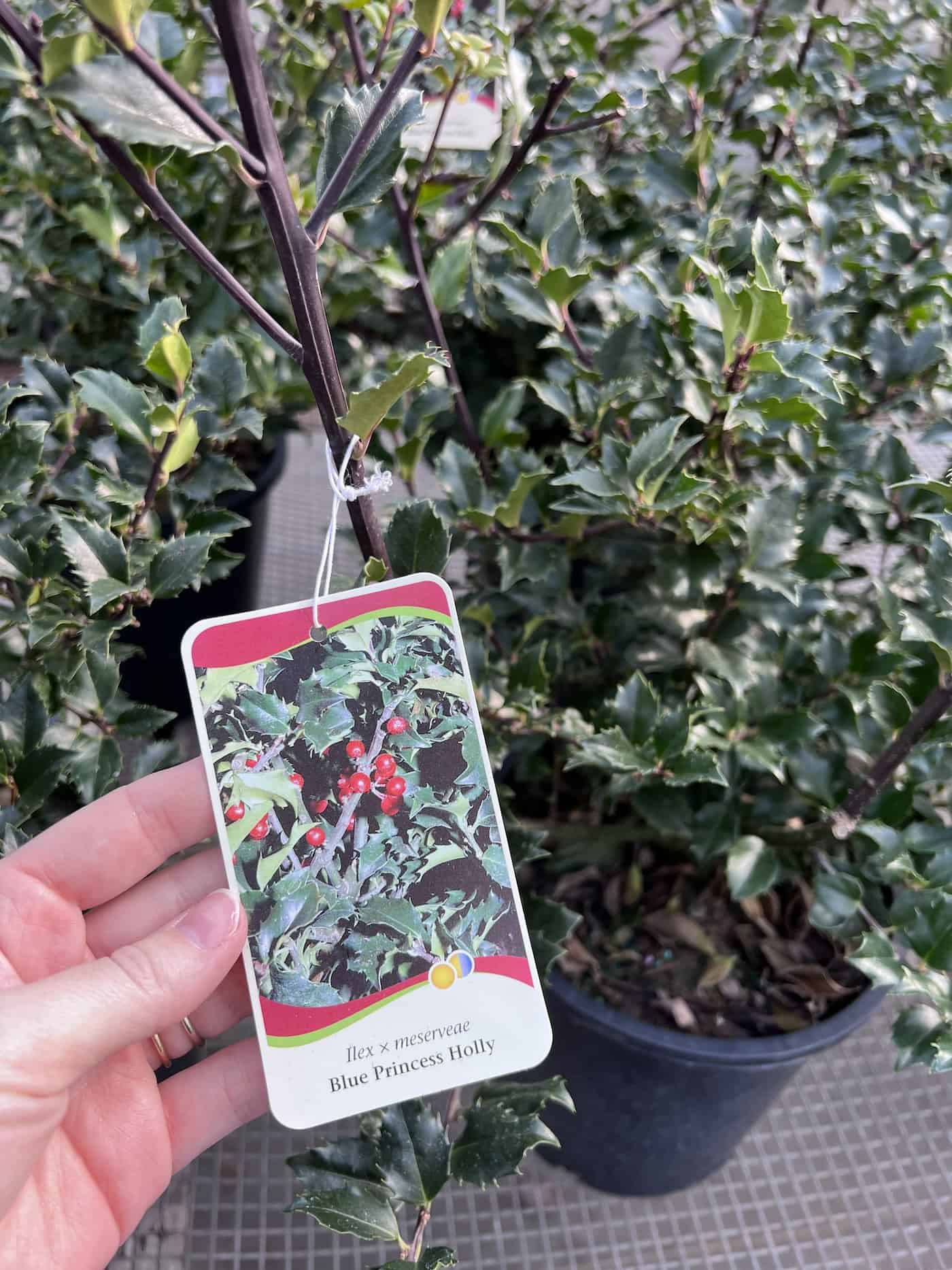
6. Holly
Holly (Ilex spp.) is renowned for its glossy, spiky leaves and bright red berries. It’s a classic choice in many landscapes for its decorative appeal. This shrub is well-suited for planting in shaded areas, as many varieties can tolerate lower light levels while maintaining their vibrant foliage and fruit.
Holly shrubs prefer well-drained, slightly acidic soil and can thrive in USDA plant hardiness zones 5 through 9. These plants are dioecious, meaning both male and female plants are needed if the female plant is to produce berries. One male holly plant can pollinate a half-dozen nearby female plants.
Annual maintenance typically involves pruning in late winter or early spring to shape the plant and encourage new growth. Additionally, applying a balanced fertilizer in spring can promote healthy foliage and berry production, which is especially important for hollies to maintain their characteristic appearance.

7. Viburnum
Viburnum (Viburnum spp.) is known for its attractive foliage, fragrant flowers, and colorful berries. This plant is a great choice for shaded areas as many species of Viburnum can tolerate and even thrive in partial to full shade, offering a splash of color and texture where other plants may not flourish.
Viburnums are hardy in USDA plant hardiness zones 2 through 9, covering a wide geographical range. Like most shrubs, they generally prefer well-drained, fertile soil.
Annual maintenance for Viburnum typically includes pruning after the shrub finishes flowering to maintain shape and encourage bushier growth. It’s also beneficial to apply a layer of mulch around the base to retain moisture and provide nutrients, along with occasional watering during dry periods.
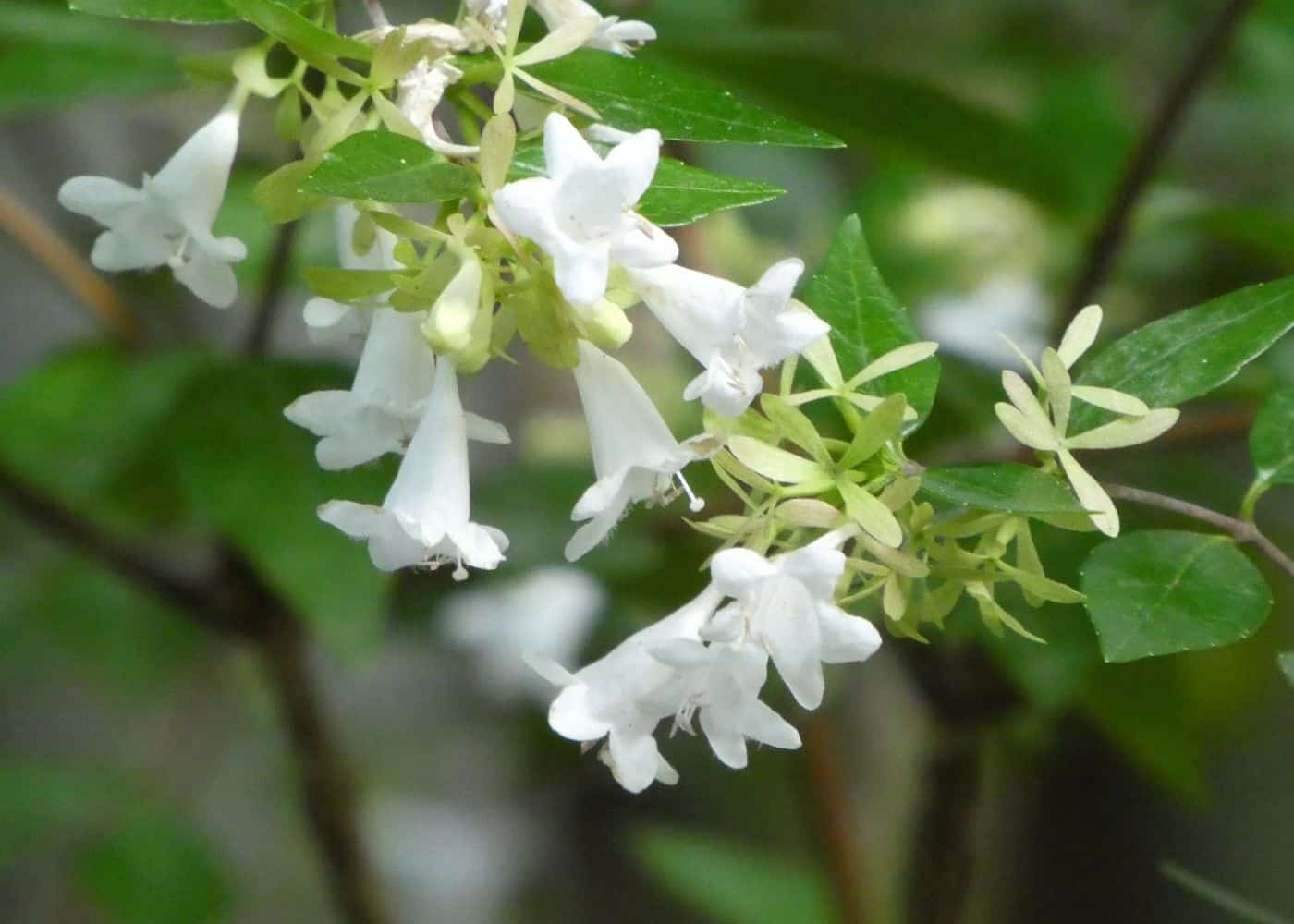
8. Abelia
Abelia (Abelia spp.) has little pink flowers, a long blooming period, and attractive, arching branches. This shrub is well-suited for shaded areas, where it can provide a backdrop of continuous blooms and vibrant foliage, brightening up less sunny spots.
Abelias thrive in well-drained soil and are hardy in USDA plant hardiness zones 5 through 9. Annual maintenance for Abelias includes pruning in late winter or early spring to encourage new growth and maintain the desired shape.
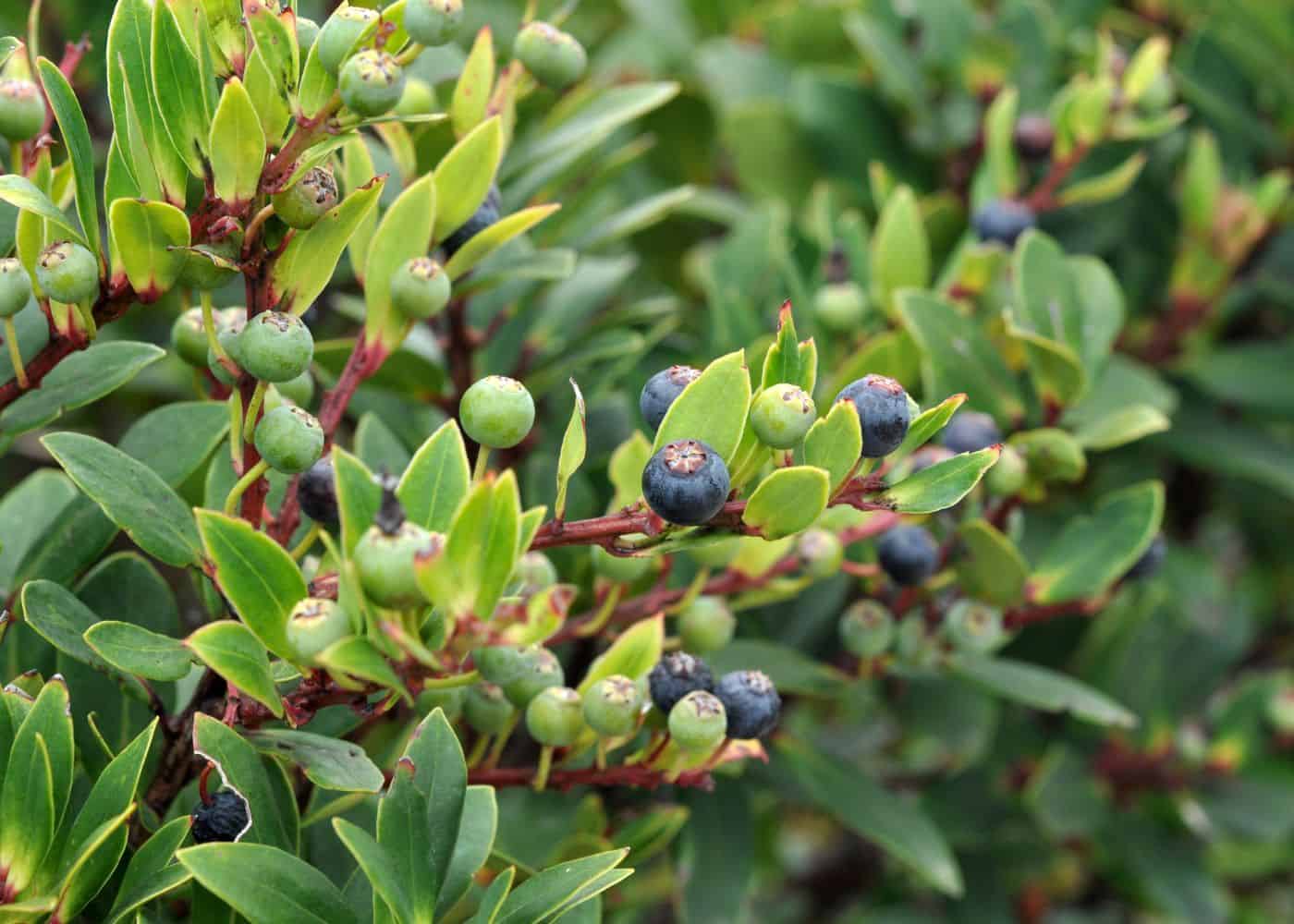
9. Huckleberry
Huckleberry (Vaccinium spp.) is notable for both its edible berries and attractive foliage, making it a valued addition to the landscape. This plant is a good choice for shaded locations, as it naturally grows in understory habitats, thriving in dappled sunlight or partial shade.
Huckleberries are hardy in cooler climates and thrive in USDA plant hardiness zones 3 through 7. They prefer acidic, well-drained soil rich in organic matter. These shrubs require a consistent moisture level, especially during the growing and fruiting seasons.
Annual maintenance includes mulching to retain soil moisture and protect the root system and light pruning to remove dead or overcrowded branches, which encourages healthy growth and berry production. While huckleberries are low-maintenance, they may benefit from an acid-forming fertilizer in early spring, especially if the soil pH is not naturally low.
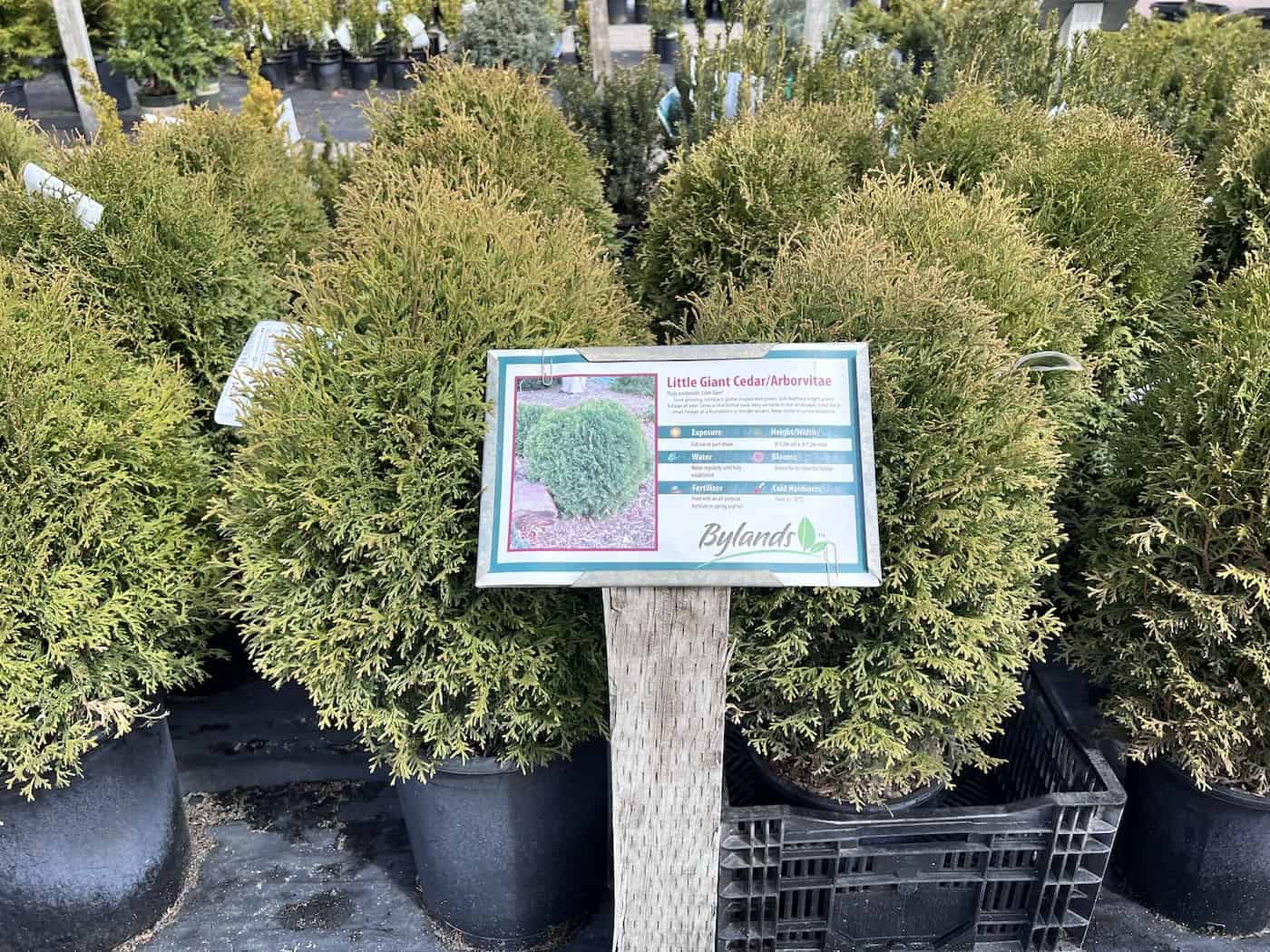
10. Arborvitae
Arborvitae (Thuja spp.) is a popular evergreen choice for hedges and privacy screens in landscaping. While it does like the sun, certain varieties can tolerate partial shade, making it a versatile option for different garden locations. And in hot climates, afternoon shade is almost a must-have if you don’t want to water them daily.
Arborvitaes are hardy in USDA plant hardiness zones 2 through 7. In zones 6 and 7, they will either require frequent watering or afternoon shade to make it through summertime dry spells. These shrubs benefit from being planted in an area protected from harsh winds, especially in winter.
Annual maintenance typically includes checking for and addressing any pest or disease issues and applying a balanced fertilizer in early spring to promote healthy growth. Pruning is generally minimal but can be done in early spring to maintain shape and encourage denser foliage.
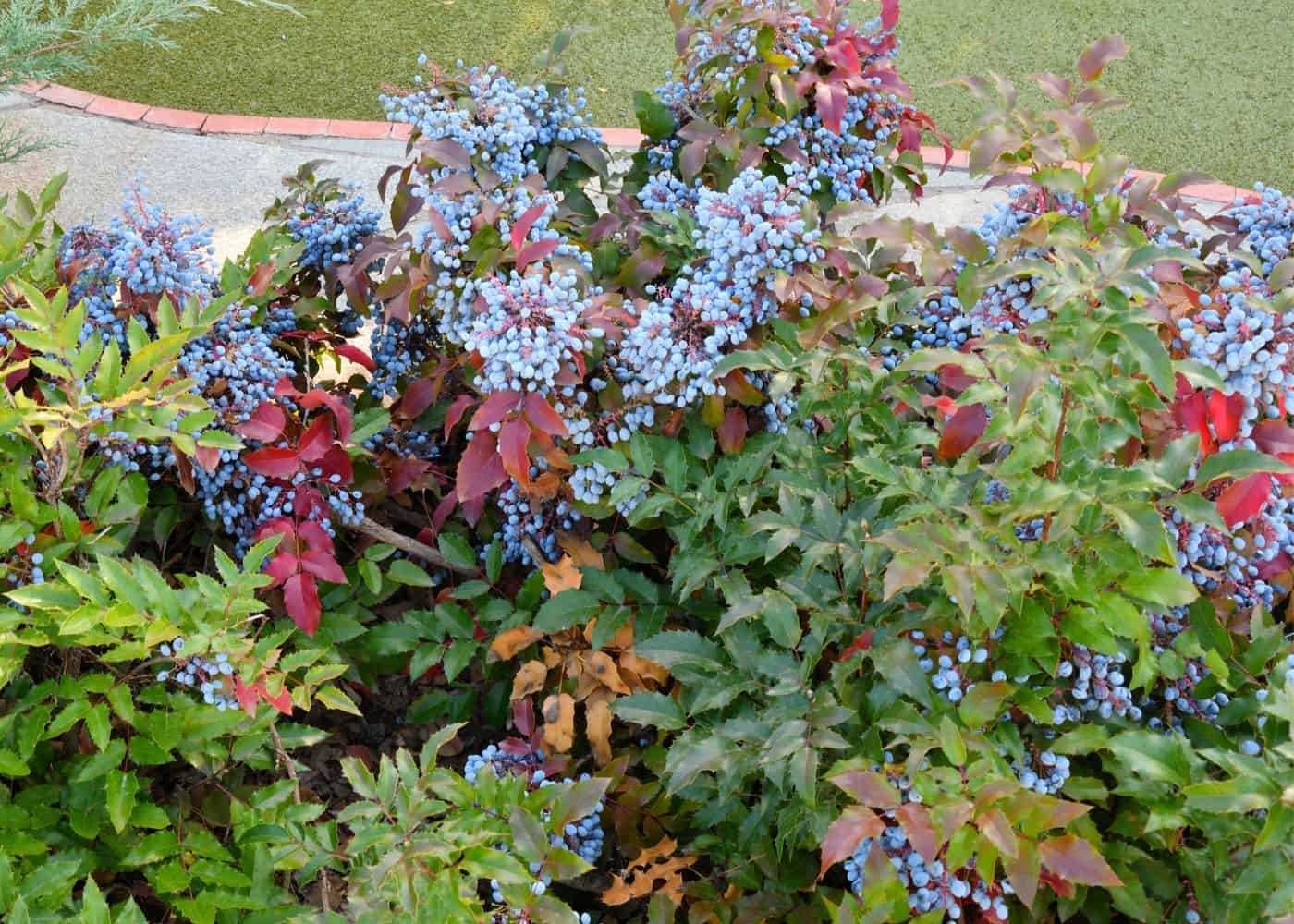
11. Mahonia
Mahonia (Mahonia spp.) has spiky, holly-like leaves and bright yellow flowers. This shrub is particularly suited for shaded locations, as it naturally grows in understory conditions and can flourish with limited sunlight.
Mahonias are hardy in USDA plant hardiness zones 5 through 9, making them adaptable to various temperate climates. They thrive in prefer well-drained, slightly acidic soil and in partial to full shade.
Annual maintenance for Mahonia includes pruning in late winter or early spring to remove any dead or overcrowded branches (right at the base) and to maintain their overall shape. Additionally, applying a layer of mulch helps retain soil moisture and protect the roots. These tough plants are generally just fine without any added fertilizer.

12. Rhododendron
Rhododendron (Rhododendron spp.) is celebrated for its spectacular blooms and lush, evergreen foliage. This shrub is an excellent choice for shaded areas in landscaping, as many varieties flourish in partial shade, ideal for creating a vibrant display in cooler, less sunny spots.
Rhododendrons prefer well-drained, acidic soil and are hardy in USDA plant hardiness zones 5 through 8, making them versatile for different temperate climates. They require protection from strong winds and prefer a sheltered location, ideally under the canopy of tall trees. They also tend to to better in humid, coastal climates.
Annual maintenance includes mulching to maintain soil moisture and acidity, and pruning immediately after flowering to remove dead flowers and promote bushier growth. Regular watering, especially during dry spells, and applying an acid-forming fertilizer in spring can help keep them at their best.
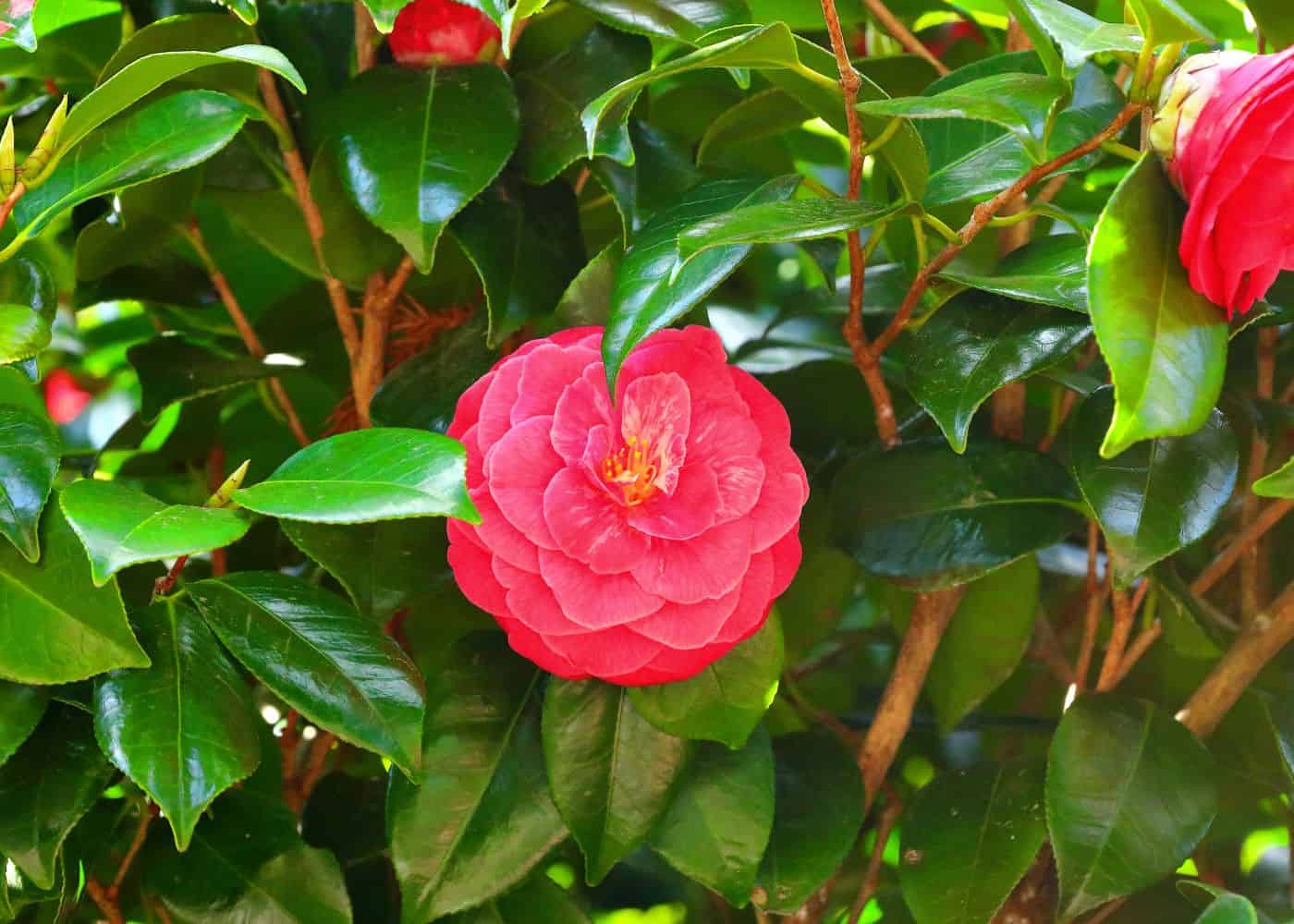
13. Camellia
Camellia (Camellia spp.) is renowned for its beautiful, rose-like flowers and glossy evergreen leaves. This flowering plant is ideal for shaded locations in landscaping, as it prefers protection from direct afternoon sunlight, thriving in dappled or partial shade.
Camellias are best suited to well-drained, acidic soil and are hardy in USDA plant hardiness zones 7 through 10. While not suitable for climates with frozen winters, they are a great choice for milder climates. They require consistent moisture but are sensitive to overwatering, so well-draining soil is essential.
Annual maintenance involves pruning after blooming to maintain shape and encourage healthy growth and applying a layer of mulch to conserve moisture and protect the roots. Additionally, a fertilizer formulated for acid-loving plants can be applied in spring and mid-summer to support their flowering and overall health.

14. Spice Bush
Spice bush (Calycanthus occidentalis) is a deciduous shrub known for its aromatic foliage and maroon flowers. It is well-suited for planting in shaded areas, as it naturally grows in woodland settings and can thrive with limited direct sunlight.
Spice bush prefers moist, well-drained soil rich in organic matter, and it is hardy in USDA plant hardiness zones 6 through 9. Some cultivars can survive in zone 5 with winter protection. It is adaptable to both full sun and partial shade, though it flourishes best in the latter, making it versatile for various landscape designs.
Annual maintenance includes pruning in late winter or early spring to remove any dead or diseased wood and to encourage bushier growth. Mulching around the base helps retain soil moisture, and an annual application of a balanced, slow-release fertilizer can promote healthy growth and flowering.

15. Japanese aralia
Japanese aralia (Fatsia japonica) is a striking broadleaf evergreen known for its very large, glossy leaves. It has an umbrella-like canopy that can get quite broad on a mature specimen. This is a superb choice for shaded locations in landscaping, as it naturally thrives in low light conditions, bringing lush, tropical-like foliage to darker garden areas.
This plant prefers well-drained, fertile soil and is hardy in USDA plant hardiness zones 8 through 10, making it suitable only for warmer climates. It tends to thrive in humid coastal climates, as the broad leaves are not overly tolerant of drought conditions. Japanese Aralia also enjoys a sheltered spot, protected from harsh winds and extreme cold.
Annual maintenance includes removing any damaged or dead foliage to keep the plant looking tidy and to encourage new growth. While it requires minimal pruning, an occasional light trim can help maintain its shape and size. Additionally, a layer of mulch can be applied to conserve soil moisture and provide nutrients.
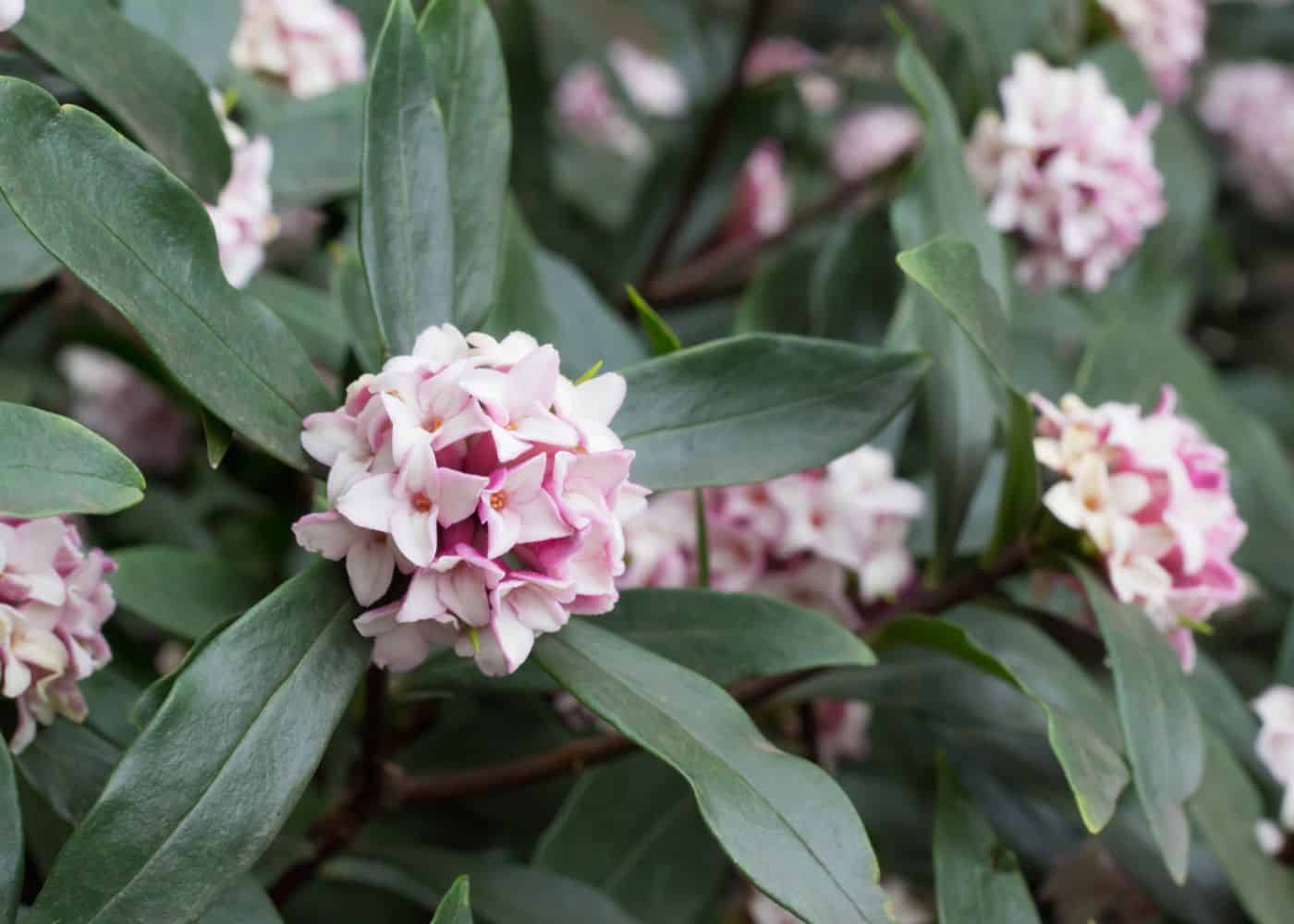
16. Daphne
Daphne (Daphne spp.) is a flowering broadleaf evergreen celebrated for its fragrant flowers and attractive berries. This small shrub is an excellent choice for shaded areas in landscaping, as many Daphne species prefer partial shade.
Daphnes thrive in well-drained, slightly alkaline to neutral soil. Different types vary in their cold hardiness, with some thriving in warmer zones 7-9 and others hardy down to zone 5 or even zone 4. Be sure to check the cold hardiness of your desired cultivar before you buy it. Most daphnes require protection from harsh afternoon sun and strong winds.
Minimal pruning is required. It’s generally best to only remove dead or diseased branches, as daphnes can be sensitive to heavy cutting. Mulching can help retain soil moisture and protect the roots from temperature extremes.
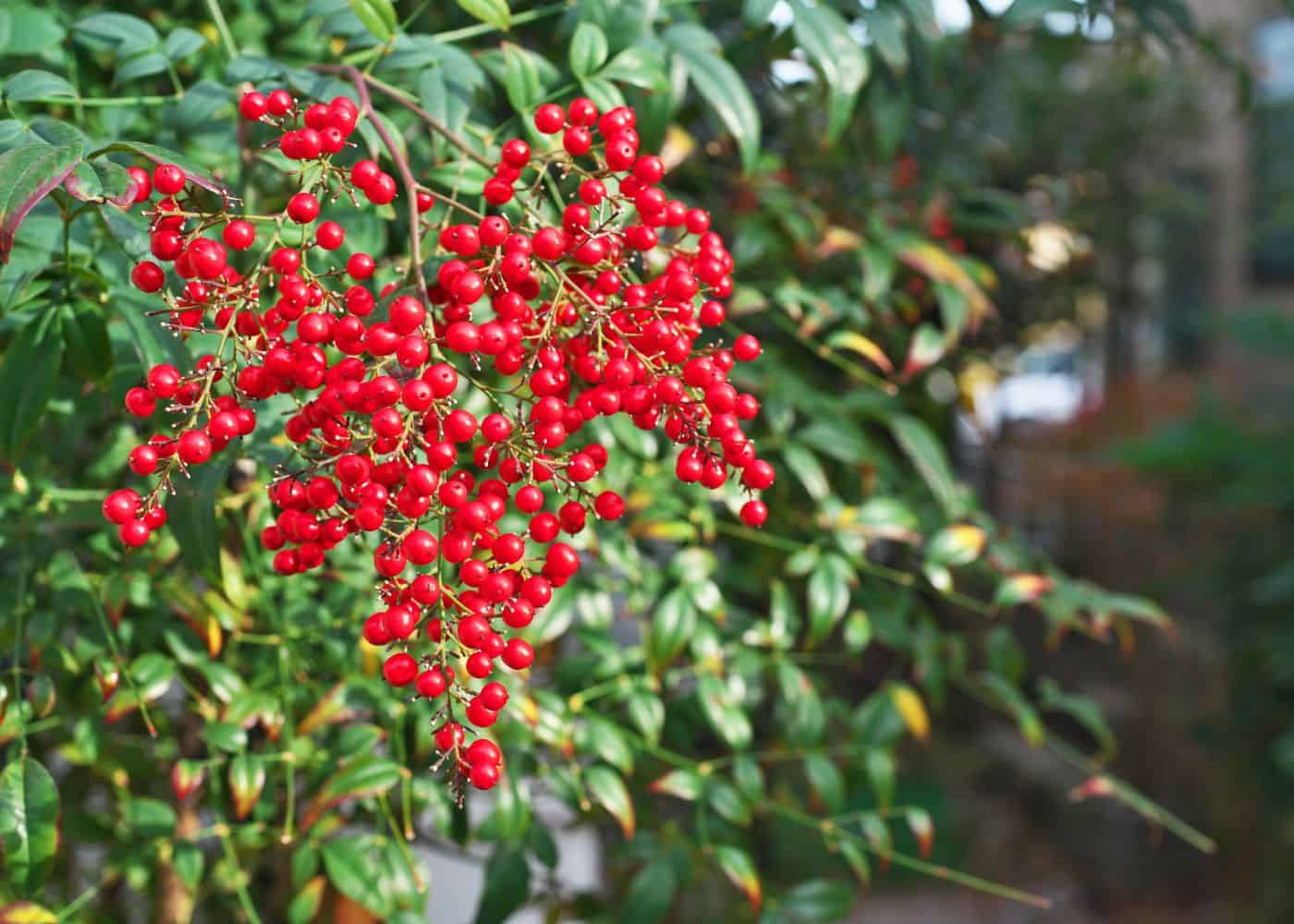
17. Heavenly bamboo
Heavenly bamboo (Nandina domestica) is an evergreen shrub known for its delicate, bamboo-like foliage and bright red berries. Despite its common name, it is not a true bamboo in the botanical sense. This Chinese shrub is actually part of the barberry family.
Also called sacred bamboo, this is a great choice for shaded areas in landscaping, as it can adapt to a variety of light conditions, from full sun to partial shade, providing year-round interest even in less sunny spots. Heavenly Bamboo thrives in well-drained soil and is hardy in USDA plant hardiness zones 6 through 9, making it suitable for a range of moderate climates. It prefers a slightly acidic to neutral soil pH and benefits from a sheltered position to protect it from harsh winter winds.
Annual maintenance includes pruning in late winter or early spring to remove any dead or weak stems and to encourage new growth. While generally low-maintenance, applying a balanced fertilizer in early spring can help promote healthy foliage and berry production, and mulching helps retain soil moisture and protect the roots.

18. Japanese ternstroemia
Japanese ternstroemia (Ternstroemia gymnanthera) is a visually striking evergreen shrub with glossy leaves and small, white flowers. This plant is an excellent choice for shaded areas in landscaping, as it flourishes in part to full shade.
Japanese ternstroemia thrives in well-drained, acidic to neutral soil and is hardy in USDA plant hardiness zones 7 through 10, making it ideal for warmer climates. It prefers a sheltered location, away from harsh winds and extreme cold.
Annual maintenance for this shrub is minimal; it typically requires only light pruning to remove any dead or damaged branches and to maintain its shape. Additionally, a layer of mulch can be beneficial to retain soil moisture and protect the root system.
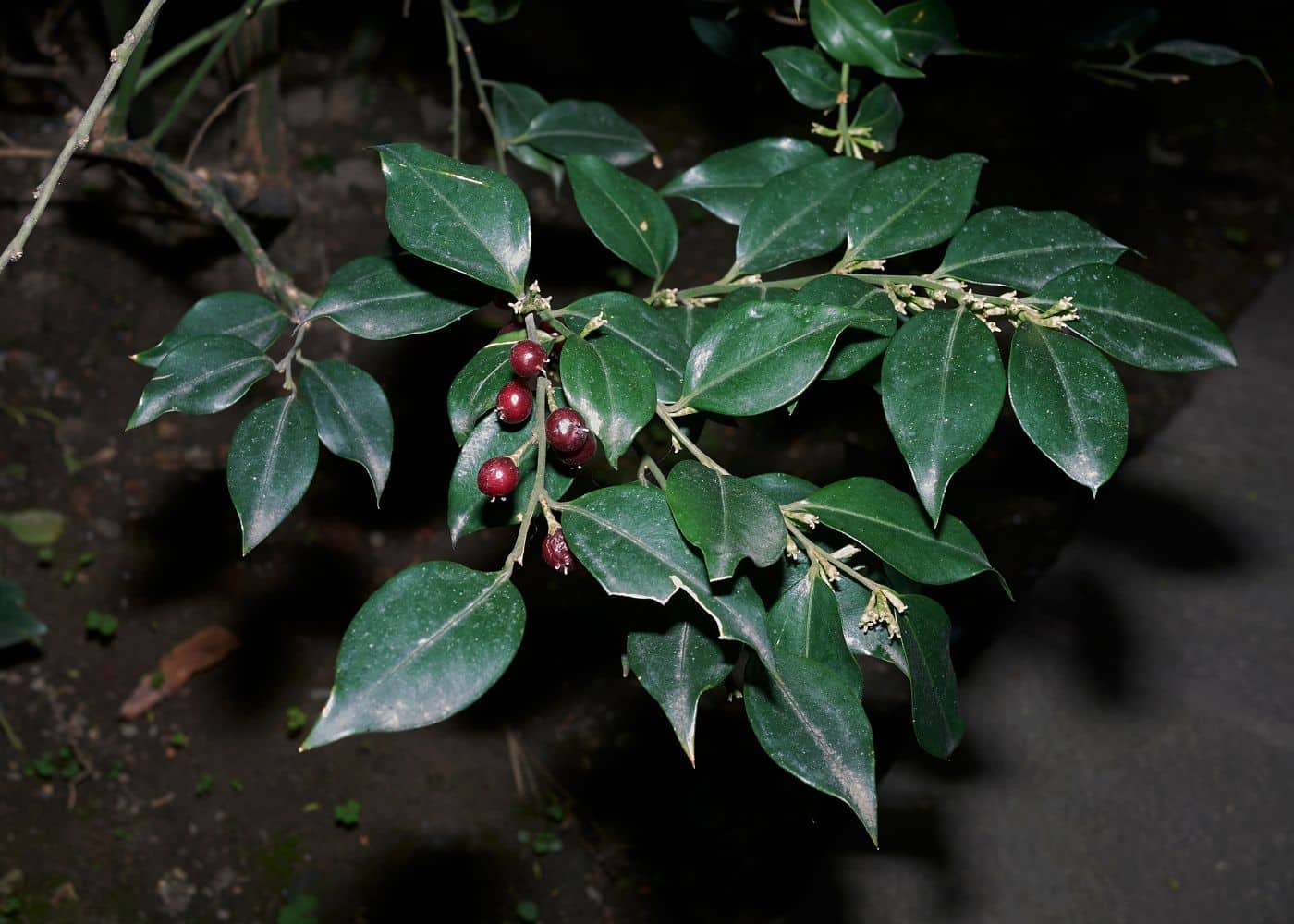
19. Sweetbox
Sweet box (Sarcococca) is a low-growing evergreen shrub known for its fragrant winter flowers and glossy leaves. This plant is ideal for shaded locations in landscaping, as it thrives in partial to full shade.
Sweet Box prefers well-drained, fertile soil and is hardy in USDA plant hardiness zones 6 through 9. This shrub benefits from being planted in an area protected from cold, drying winds. Yearly maintenance typically involves light pruning after flowering to maintain shape and encourage healthy growth.
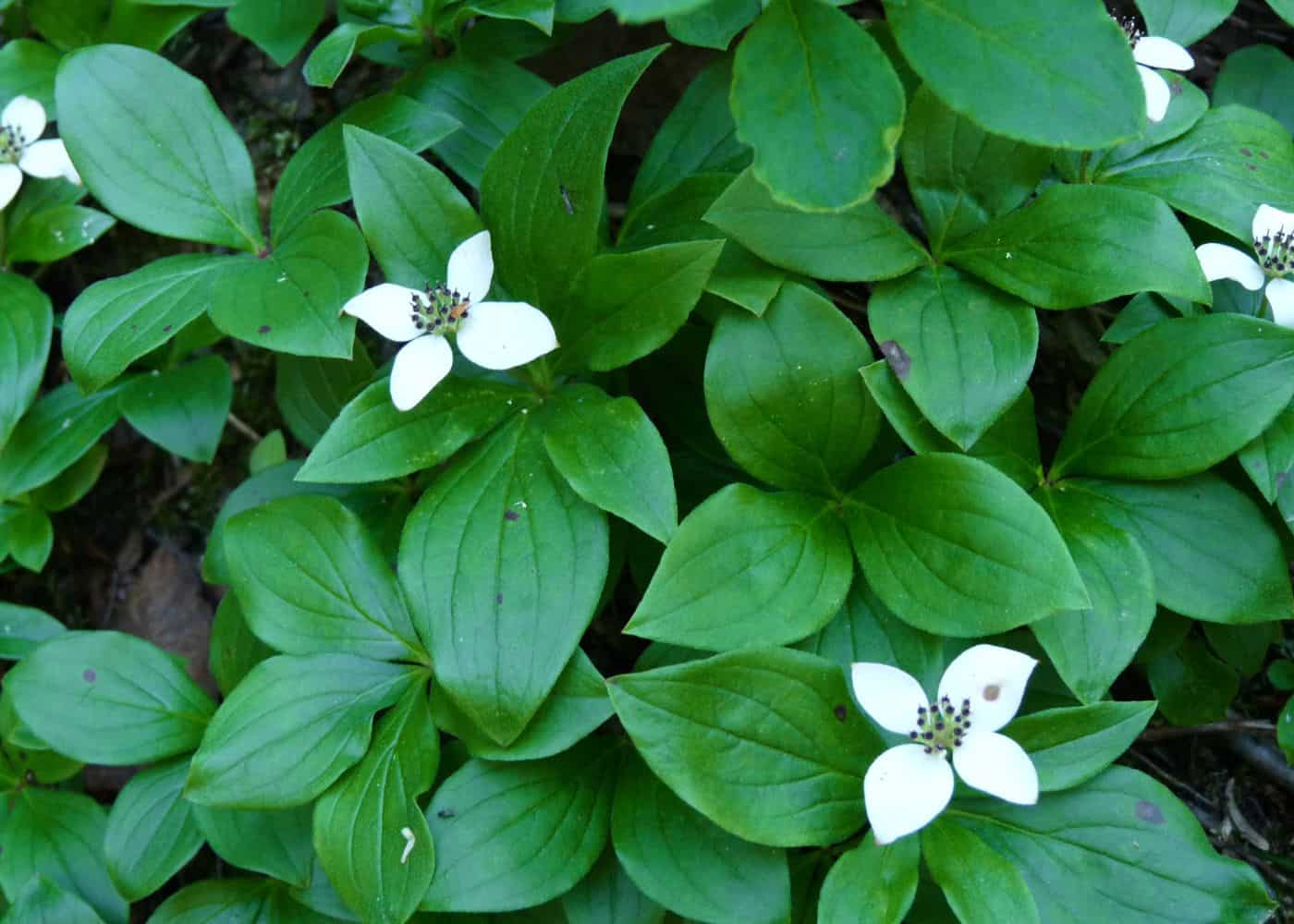
20. Bunchberry
Bunchberry (Cornus canadensis) is a lovely low-growing deciduous shrublike plant in the dogwood family known for its charming white flowers and red berries. This plant is a good choice for shaded locations in landscaping, as it naturally grows in forest understories and thrives in dappled sunlight or full shade.
Bunchberry is hardy in USDA plant hardiness zones 2 through 7, making it suitable for cooler climates. This ground-cover shrub does best in a cool, shaded environment, away from the heat of direct afternoon sun. Like many other shrubs on this list, they do best in cool, moist, acidic soil rich in organic matter.
Annual maintenance is minimal, typically involving keeping the soil consistently moist and removing any leaf litter to prevent fungal diseases. While bunchberry does not require regular pruning, occasional thinning of the oldest branches can help maintain its health and appearance. A layer of organic mulch can also be beneficial to retain soil moisture and suppress weeds.
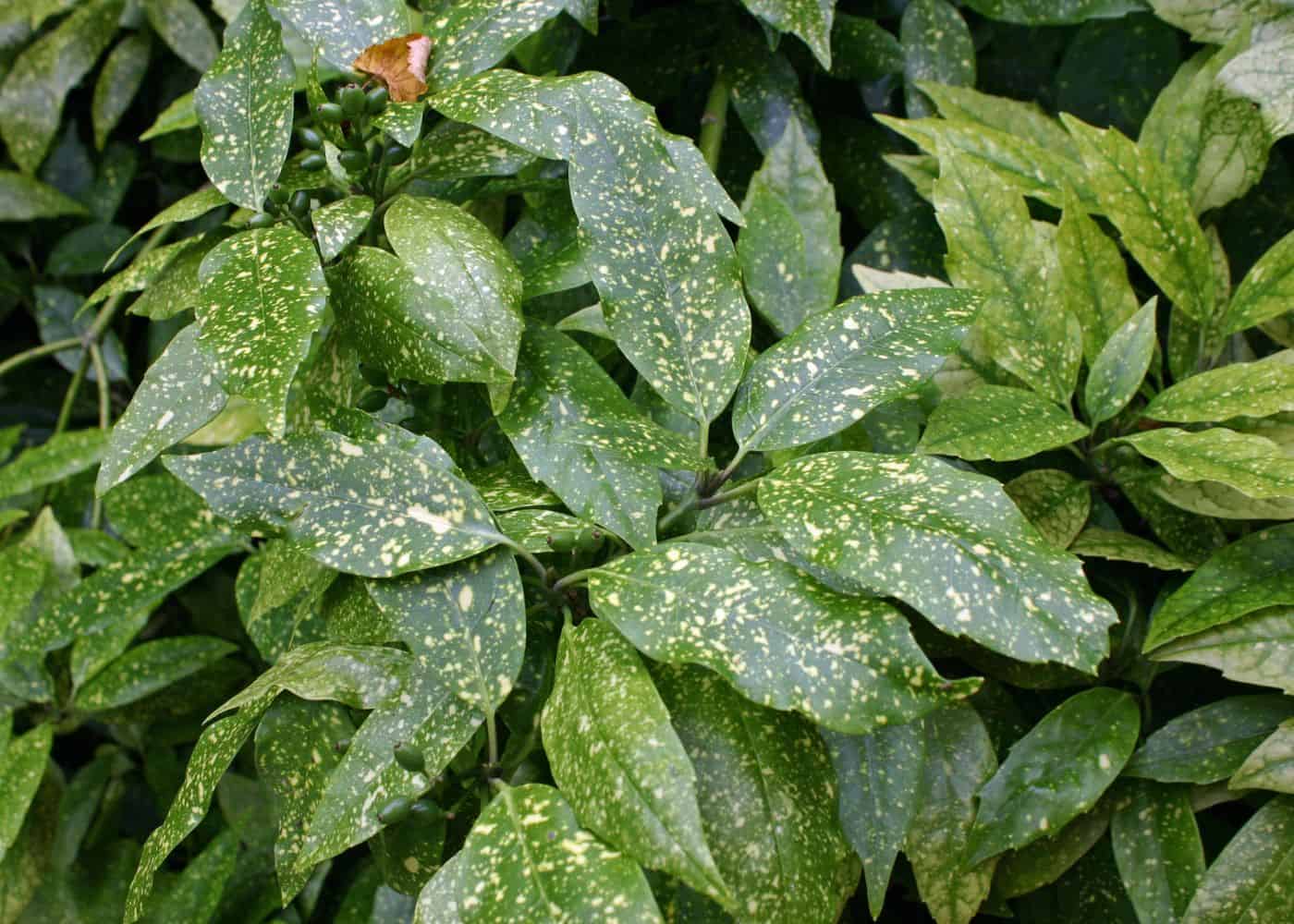
21. Japanese laurel
Japanese laurel (Aucuba japonica) is an evergreen shrub grown for its glossy, green leaves that are often speckled with gold. It is an excellent choice for shaded locations in landscaping, as it thrives in low-light conditions. In the landscape, it adds brightness and variegation to darker areas.
Japanese Laurel prefers well-drained, fertile soil and is hardy in USDA plant hardiness zones 7 through 10, making it suitable for a variety of warmer climates. This plant enjoys a sheltered position, protected from cold, drying winds and extreme frosts. Annual maintenance typically involves light pruning in early spring to shape the plant and encourage new growth.
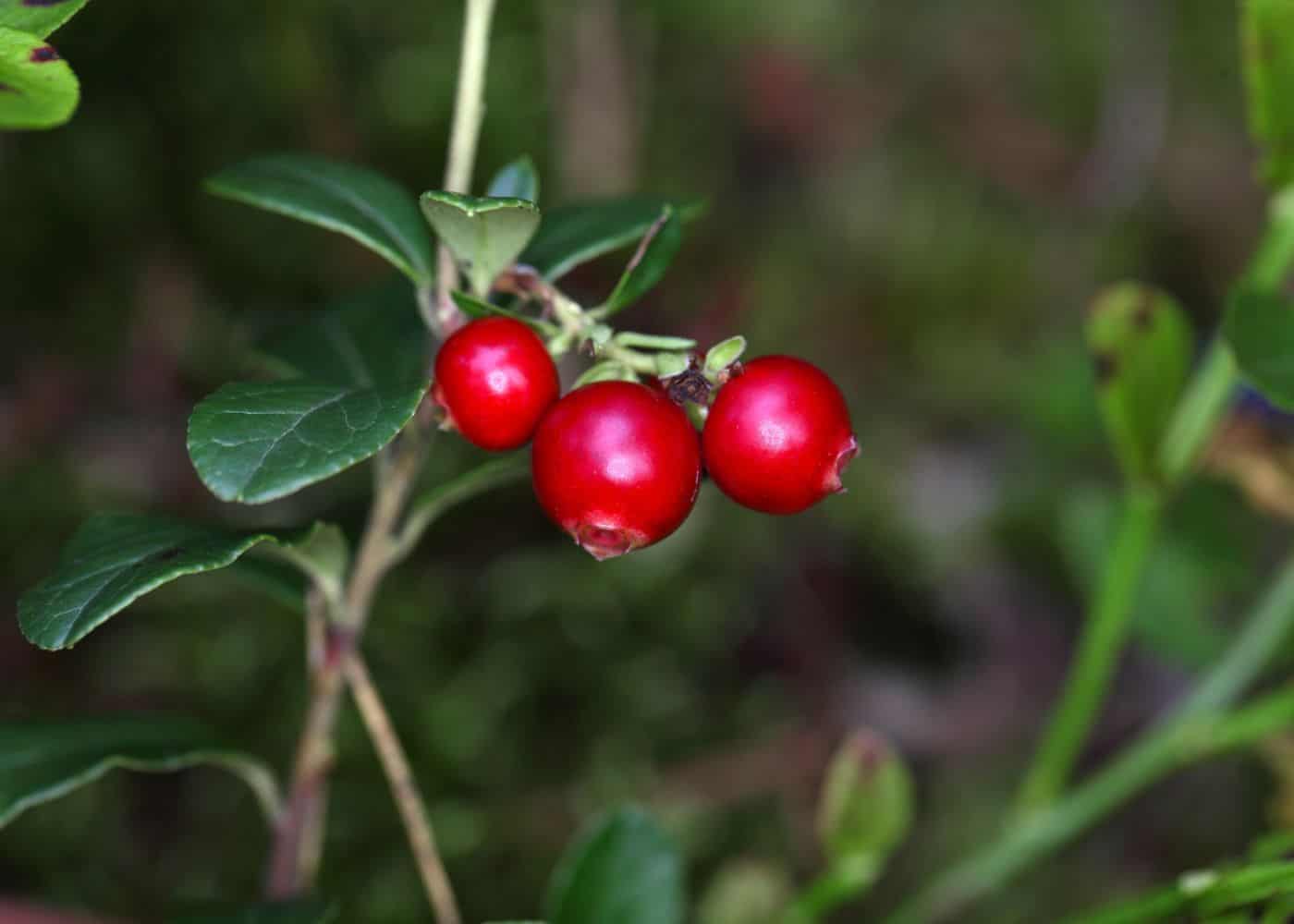
22. Lingonberry
Lingonberry (Vaccinium vitis-idaea) is a little evergreen shrub prized for its tart, edible berries and attractive foliage. This plant is well-suited for shaded locations in landscaping, as it naturally grows in forest understories and can flourish in partial shade.
Lingonberries are best for cooler climates and are hardy in USDA plant hardiness zones 2 through 7. They prefer acidic, well-drained soil and cool, moist environments.
Annual maintenance for lingonberries includes mulching to retain soil moisture and pruning to remove dead or diseased wood. While generally low-maintenance, they benefit from occasional watering during dry periods and an application of fertilizer formulated for acid-loving plants in early spring to encourage healthy growth and fruit production.
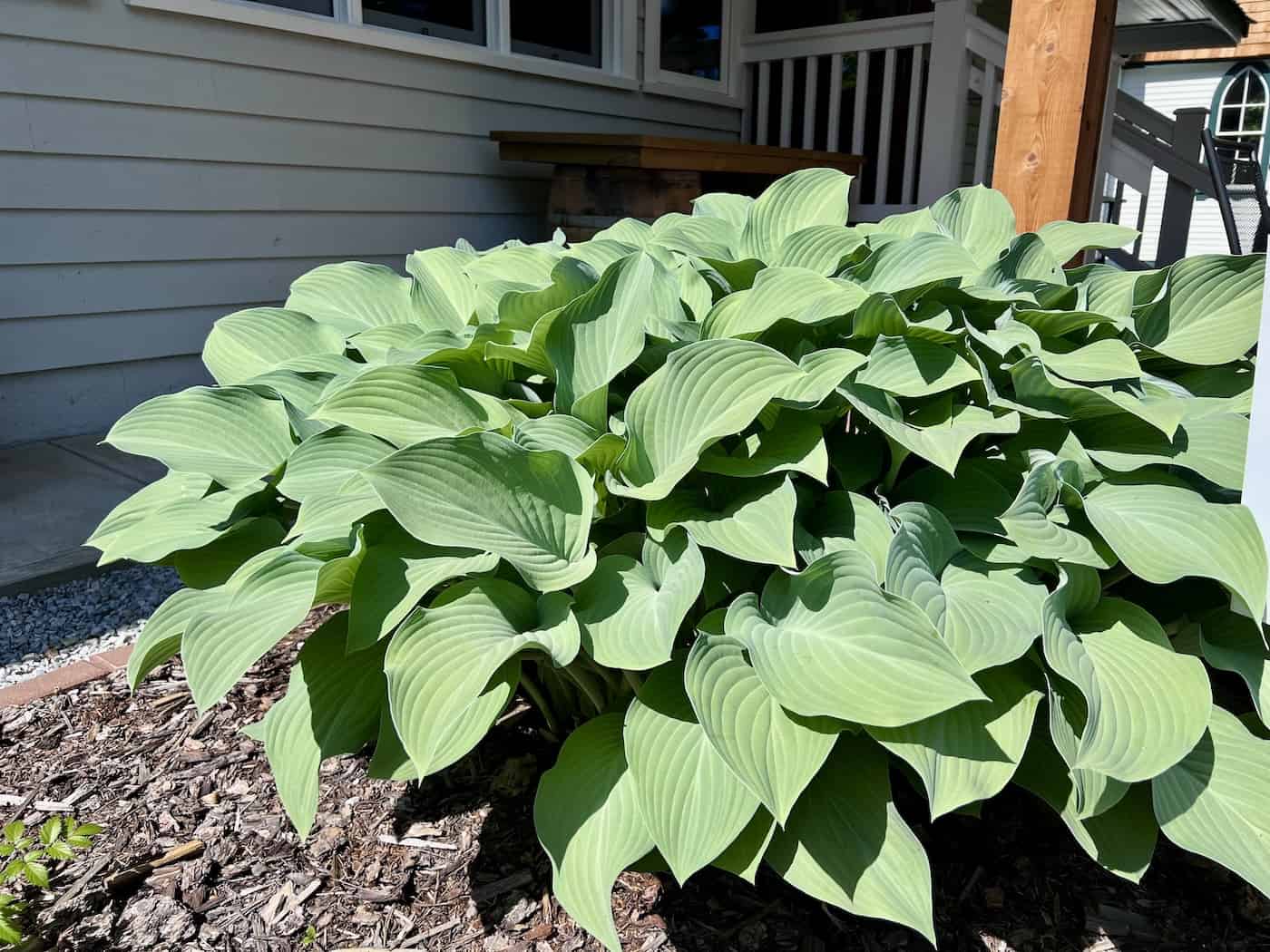
23. Hosta
Hostas (Hosta spp.) are not technically a shrub, but they can sometimes function like one in a landscape design. These herbaceous perennials come in a huge range of sizes, and the larger ones can certainly take the place of a shrub in a smaller-scale planting area.
Hostas have a very wide climate range and can be grown in zones 2-9. Protective mulch over the plant in the winter can be helpful at the coldest end of the range (typically zones 2-3). At the warm end of the range (zones 8-9), choose heat-tolerant varieties if possible.


